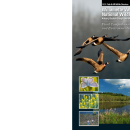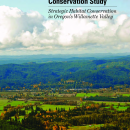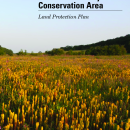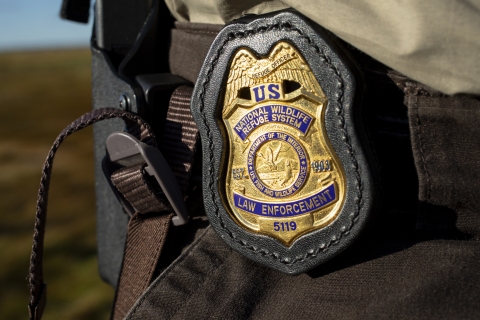What We Do
The National Wildlife Refuge System is a series of lands and waters owned and managed by the U.S. Fish and Wildlife Service. Wildlife conservation is at the heart of the refuge system. It drives everything we do from the purpose a refuge is established, to the recreational activities offered there, to the resource management tools we use. Selecting the right tools helps us ensure the survival of local plants and animals and helps fulfill the purpose of the refuge.
The Willamette Valley National Wildlife Refuges provide migrating Canada geese with what they need to survive during the fall and winter and make the trek back to the Copper River Delta in Alaska in the spring. To prepare for the spring flight and subsequent nesting period, geese need food, water, and sanctuary. All of these items are provided on the Willamette Valley Refuges where thousands of geese spend the winter. The Willamette Valley National Wildlife Refuge Complex works to restore and maintain historic native habitats such as Oak Savanna, Oak Woodlands, Riparian Forest, Wetlands, Prairie, and more!
Resource management is one of the number one conservation focuses on the refuge. This ranges from the management of rare habitat types to wildlife population surveys and designated sanctuary areas.
Management and Conservation
Management Techniques
To help plants and wildlife, refuge staff uses a variety of habitat management techniques to maintain, recover or enhance plant and wildlife values. Refuge staff carefully considers any management techniques and employs them in varying degrees according to the situation.
Water levels are carefully monitored and controlled to foster desired plant growth. Sometimes, sensitive areas are closed to the public so that the land can recover more quickly. Prescribed burning, mowing, and seeding are also some of the techniques used to help native plants recover on National Wildlife Refuges.
Standardized ground and aerial wildlife surveys and vegetation surveys are conducted on some refuges throughout the year to inventory populations and document habitat use. Units are evaluated by how well they met habitat and wildlife use objectives.
Rare Habitats
At Ankeny NWR, carefully evaluated management techniques are vital due to the rare habitats found here. For example, prairie habitat was once the most widespread type in the Willamette Valley, now very little of this area is left intact. Prairie habitat supports birds such as the western meadowlark and Oregon vesper sparrow, as well as the recently listed streaked horned lark which is now designated as a threatened species. Several threatened and endangered plant species plant species can also be found there.
Resource Management:
- Habitat Management
- Managing For Geese
- Hunt Program
- Conservation Planning
Refuges use a wide range of land management tools based on the best science available. Some refuges use prescribed fires to mimic natural fires that would have cleared old vegetation from the land helping native plants regenerate and local wildlife to thrive. Other refuges contain Wilderness areas where land is largely managed in passively. The management tools used are aimed at ensuring a balanced conservation approach where both wildlife and people will benefit.
1. Habitat Management
Prescribed Burning
The Willamette Valley National Wildlife Refuge Complex (NWRC) has an active prescribed burning program. The objectives of these burns are to restore and maintain native prairies and oak savannas, enhance populations of threatened and endangered species, improve food crops for Canada geese, and reduce the risks for severe wildfire. Most burning takes place in the late summer or early fall.
Agricultural lands
Through cooperative agreements with local farmers, refuge fields are planted to grow ryegrass, fescue, corn, and pasture mixes. These crops are the preferred food for wintering geese. During the winter months thousands of geese feed on the crops planted by farmers. These farming operations help reduce off-refuge crop damage by migratory birds.
Weed Control
Control of non-native, invasive weeds is an important management operation. Weeds present the single most significant threat to native plant communities and rare species. The refuge uses a combination of mowing, burning, slashing, hand pulling and herbicides to keep weeds in check.
Prairie Restoration
Throughout the refuges, former croplands are in different stages of being restored to native habitats. This process, which takes a number of years, includes clean-up of the fields of weeds and residual crops, site preparation for planting of native species and maintenance of the developing habitats.
The refuges are actively restoring both wetland and upland prairies and are working to enhance existing prairies that have been invaded by shrubs and small trees. The woody vegetation is cut and piled off-site where it is burned. Most treatment areas are selected to provide benefits to threatened and endangered plant species.
Water Management
Seasonally flooded wetlands require continual management to produce plants favored by waterfowl and other water-birds. Water levels are usually “stage-flooded” in the fall and winter using water control structures that allow variable levels. This helps maximize the food availability for migrating waterfowl. Managed levels are also important in the spring to prevent the establishment of undesirable non-native plants, like reed canary-grass. In the summer, most managed impoundments are dry, a natural cycle that native plants have adapted to.
2. Managing for Geese
The Willamette Valley Refuges provide migrating geese with what they need to survive during the fall and winter and make the trek back to Alaska in the spring. To prepare for the spring flight and subsequent nesting period, geese need food, water, and sanctuary. All of these items are provided on the Willamette Valley Refuges where thousands of geese spend the winter.
Food
Under cooperative agreements with local farmers, fields are planted in the spring with nutritious grasses preferred by geese, such as ryegrass, fescue, corn and pasture mixes. Farmers are responsible for all maintenance and care of the crop during the growing season and in the summer, they benefit from the harvest of these Refuge fields. The baled hay is generally used as feed for livestock, and once the farmers have harvested, the remaining stubs of grass are left to grow again.
In early fall these stubs start to green up as the fall rains provide necessary water to jumpstart their second growth. As the crops grow the geese are returning to the Refuge where they begin to appear in large numbers on the Refuge fields. Exhausted from their long flight south, the geese can then replenish their energy reserves on these nutritious greens.
By providing the geese with high quality food, the amount of off-Refuge crop depredation is reduced, thus benefiting not only the birds, but also the surrounding private lands.
Water
The Willamette Valley was once a vast wetland during the winter months due to flooding of the Willamette River and its tributaries. Since European settlement, dams have been built, and fields have been drained and tiled for crop production. The number of wetlands and wet prairies in the Valley have dramatically declined, resulting in smaller areas suitable for the geese.
Geese need water for resting and foraging habitat. The Willamette Valley Refuges have wetlands and wet prairies that provide both food and resting areas for wintering geese. Many Refuge wetlands occur naturally, while dikes and levees impound water to create others.
Seasonally flooded wetlands require continual management to produce plants favored by wintering waterfowl. Water levels are usually “stage-flooded” in the fall and winter using water control structures that allow for variable water levels. This helps maximize the food availability for migrating waterfowl including Canada geese.
Water levels are also important in the spring to prevent the establishment of undesirable non-native plants. In the summer, most impoundments are dry--a natural cycle that native plants have adapted to.
Sanctuary
Wintering waterfowl start to arrive on the Willamette Valley Refuges in early fall and stay until early spring. During this time the Refuges close the interior sections to public use to provide undisturbed habitat for the wintering waterfowl.
By resting in undisturbed areas on the refuges, wintering geese replenish their energy reserves required for migrating and nesting. The birds are able to browse Refuge fields, and forage and rest in the wetlands without being disturbed. This undisturbed sanctuary also makes the Refuge preferable to the geese than surrounding private lands, which serves to further prevent unwanted crop depredation.
3. Hunt Program
Currently there are no hunting opportunities at Ankeny National Wildlife Refuge.
4. Conservation Planning
The Willamette Valley National Wildlife Refuge Complex manages a variety of native habitats: wet prairie, oak savanna, upland prairie, mixed forest, oak woodland and hardwood riparian riparian
Definition of riparian habitat or riparian areas.
Learn more about riparian forest. Decisions on the habitats we provide, the wildlife they support, and how we manage them were part of the development of our CCP, or Comprehensive Conservation Plan.
Beyond the 10,000+ Willamette Valley National Wildlife Refuge Complex acres, the Private Lands Program works to conserve native habitats on private lands. Creating, restoring and maintaining native Willamette Valley habitats up and down the Valley - whether it be on a national wildlife refuge national wildlife refuge
A national wildlife refuge is typically a contiguous area of land and water managed by the U.S. Fish and Wildlife Service for the conservation and, where appropriate, restoration of fish, wildlife and plant resources and their habitats for the benefit of present and future generations of Americans.
Learn more about national wildlife refuge or private parcel - is what we work hard to achieve for wildlife and the American people. Read more about our conservation efforts in the Willamette Valley Conservation Study.
The U.S. Fish and Wildlife Service is embarking on an exciting plan that will help preserve key conservation areas in the middle and southern sections of the Willamette Valley. The Service developed a Land Protection Plan, which created the Willamette Valley Conservation Area (WVCA).
Conservation
Comprehensive Conservation Plan
A conservation and management plan for Ankeny National Wildlife Refuge was completed in 2011. The plan, known as a “comprehensive conservation plan” (CCP) was written for all three refuges in the Willamette Valley Refuge Complex (Ankeny, Baskett Slough, and W.L. Finley). The purpose of a CCP is to specify a management direction for the Refuge for the next 15 years. The goals, objectives, and strategies for improving Refuge conditions—including the habitat and public use facilities we will provide, partnership opportunities, and management actions needed to achieve desired conditions – are described in the CCP.
National Wildlife Refuge System Improvement Act
For almost a century, the 95-million-acre National Wildlife Refuge System had been managed by the U.S. Fish and Wildlife Service under a variety of laws without an "Organic Act" or comprehensive legislation spelling out how it ought to be managed and used by the public. On October 9, 1997, President Clinton signed the National Wildlife Refuge System Improvement Act of 1997 (Public Law 105-57). The Act amends the National Wildlife Refuge System Administration Act of 1966 in a manner that provides an “Organic Act” for the Refuge System.
National Wildlife Refuge System Improvement Act of 1997: The NWRS Improvement Act defines a unifying mission for all refuges, including a process for determining compatible uses on refuges, and requiring that each refuge be managed according to a CCP. The NWRS Improvement Act expressly states that wildlife conservation is the priority of System lands and that the Secretary shall ensure that the biological integrity, diversity, and environmental health of refuge lands are maintained. Each refuge must be managed to fulfill the specific purposes for which the refuge was established and the System mission. The first priority of each refuge is to conserve, manage, and if needed, restore fish and wildlife populations and habitats according to its purpose.
The Act was passed to ensure that the Refuge System is managed as a national system of related lands, waters, and interests for the protection and conservation of our Nation's wildlife resources.
The only system of Federal lands devoted specifically to wildlife, the National Wildlife Refuge System is a network of diverse and strategically located habitats. More than 545 national wildlife refuges and thousands of waterfowl production areas across the United States teem with millions of migratory birds, serve as havens for hundreds of endangered species, and host an enormous variety of other plants and animals. Over 39 million people visit units of the National Wildlife Refuge System each year to enjoy a wide range of wildlife related recreational opportunities.
The passage of this Act gave guidance to the Secretary of the Interior for the overall management of the Refuge System. The Act's main components include:
- a strong and singular wildlife conservation Mission for the Refuge System;
- a requirement that the Secretary of the Interior maintain the biological integrity, diversity and environmental health of the Refuge System;
- a new process for determining compatible uses on refuges;
- a recognition that wildlife-dependent recreational uses involving hunting, fishing, wildlife observation and photography, and environmental education and interpretation, when determined to be compatible, are legitimate and appropriate public uses of the Refuge System;
- that these compatible wildlife-dependent recreational uses are the priority general public uses of the Refuge System; and
- a requirement for preparing a comprehensive conservation plan for each refuge.
Our Services
Frog Pond Photography Blind
One photo blind is available by reservation to the general public. It is located near Jefferson at Ankeny NWR off Wintel Road on Frog Pond. The best time of year to photograph wildlife on the Refuges is generally from November through April. Wading birds, ducks, geese, and raptors are usually present in large numbers throughout the winter. Other resident wildlife includes beaver, black tail deer, coyote, and squirrels. All seasons will provide a wide variety of opportunities for nature photography enthusiasts.
Making Reservation
- By web, phone or email: Advance reservations are accepted by sending an email to willamettevalley@fws.gov, by mailing a written request to the refuge at the address below, or by calling during normal business hours. Include your name, address, phone number, email address, number of people in your party and the date(s) and time(s) you wish to schedule. If corresponding by email, please enter “Wildlife Photo Blind” in the subject line.
- Reservations should be made no later than two business days prior to requested date. You must receive confirmation of your reservation prior to using the blind.
- Refuge staff will notify you by email to confirm your reservation. Print this confirmation and leave on dashboard of vehicle at trail head on the reserved day. If the date you have requested is unavailable, you will be given the option to choose another date.
- The blind is available year-round, subject to the following provisions:
- Reservations required during the winter closure season October 1 – March 31 at Ankeny NWR.
- The blind is available for use without reservations during the remainder of the year. However, other visitors may be encountered in the general vicinity of the blind during this time.
- Reservations are for the entire day. The blind may be accessed during normal refuge hours, which are sunrise until sunset.
- Walk-up reservations may be made during normal business hours, if the blinds are available. All reservations are handled out of William L. Finley NWR headquarters, just south of Corvallis off Hwy. 99W. Office hours are Monday through Friday from 8am until 4pm. The office is closed on Federal holidays.
- Please contact the refuge if you must cancel your reservation, so that others may schedule the blind.
- Reservations are taken on a first-come, first-served basis. Up to 4 advance reservations can be made up to two months ahead of time.
- You may schedule only 2 weekend days in any given month.
- There is no charge to use the blind. However donations for maintenance are appreciated and may be made to the Friends of Willamette Valley NWR Complex, PO Box 2238, Corvallis, OR 97339.
Using the Blind
- All refuge regulations must be observed.
- Walking only—no jogging, driving, or bicycling. Pets are not allowed on refuge trails. By following these regulations, you will minimize wildlife disturbance and maximize your wildlife photography opportunities.
- During winter closure season, no off-trail use is allowed. Photographers must use the established trails to access the blind.
- Staff, volunteers, or other persons may need access to the general area of the blind. We will try to minimize our impact as much as possible to the photographer.
- The blind is not handicap accessible. Please contact the refuge if assistance is required.
- There are no restrooms along the trail. Please plan accordingly. If you take a break, please leave and return to the blind quietly to minimize wildlife disturbance.
- The blind is built to comfortably accommodate two persons. Chairs are not provided.
- Smoking is not permitted in the blind.
- When exiting the blind, please secure door and all windows.
Additional Information
- Access: Park in designated parking lot north of Wintel Road and east of Pintail Marsh Parking Lot and walk a short distance along the base of the dike to the rear access door of the blind.
- The Refuge reserves the right to revoke photography privileges. Anyone found to be in violation of any conditions in these guidelines will have their photography blind privileges immediately revoked and will be asked to leave the area.
- Checklist of helpful items to bring to the blind:
- Flashlight
- Binoculars
- Field guides
- Bean bag camera rest/tripod
- Clothes appropriate for season
- Insect repellent
- Food, snacks, water
- Bag for garbage (pack it in, pack it out)
- Please leave the area and the blind the way you found it.
- Enjoy your day!
Special Use Permits
Any use of a National Wildlife Refuge that would require special access and is not covered under existing rules and regulations for wildlife dependent visitation of the refuge will require an approved for a Special Use Permit through the refuge. These special uses include any commercial activities (timber harvest, haying or grazing), research activities, or special events.
The U.S. Fish and Wildlife Service issues permits under various wildlife law and treaties at a number of offices throughout the country. Permits enable the public to engage in legitimate wildlife-related activities that would otherwise be prohibited by law. Service permit programs ensure that such activities are carried out in a manner that safeguards wildlife. Additionally, some permits promote conservation efforts by authorizing scientific research, generating data, or allowing wildlife management and rehabilitation activates to go forward.
Permits are handled by permitting programs in International Affairs (Management Authority), Endangered Species, Law Enforcement, and Migratory Birds.
Visit the National Wildlife Refuge System website for Special Use Permits.
For more detailed information or to apply for a permit, go to The U.S. Fish & Wildlife Service website.
You may also contact us directly:
Willamette Valley National Wildlife Refuge Complex Headquarters
26208 Finley Refuge Road Corvallis, OR 97333-9533
Law Enforcement
U.S. Fish and Wildlife Service law enforcement officers have a wide variety of duties and responsibilities. They enforce federal, state and refuge hunting regulations that protect migratory birds and other game species from illegal take and preserve legitimate hunting opportunities. Officers help visitors understand and obey wildlife protection laws. By fostering understanding and instilling in the visiting public an appreciation of refuge resources, laws, and regulations, our law enforcement encourages voluntary compliance through education, outreach, and law enforcement actions while in a welcoming and safe environment. Refuge law enforcement works collaboratively with law enforcement officers from other federal, tribal, state, and local agencies.
Law enforcement issues should be referred to the refuge manager. For a full list of refuge rules and policies, click here.
You may also report violations to 1-844-FWS-TIPS (397-8477) or by email at nwr_tips@fws.gov
Law enforcement (LE) is essential to virtually every aspect of wildlife conservation. Refuge Law Enforcement not only plays a big role in protecting wildlife, but also works to promote awareness of wildlife laws and protection through collaboration with refuge Visitor Services staff.
USFWS Law Enforcement's mission is to protect wildlife resources. Through the effective enforcement of Federal laws, Law Enforcement (LE) contribute to Fish and Wildlife Service efforts to recover endangered species, conserve migratory birds, preserve wildlife habitat, safeguard fisheries, combat invasive species invasive species
An invasive species is any plant or animal that has spread or been introduced into a new area where they are, or could, cause harm to the environment, economy, or human, animal, or plant health. Their unwelcome presence can destroy ecosystems and cost millions of dollars.
Learn more about invasive species , and promote international wildlife conservation. Service LE focus on potentially devastating threats to wildlife resources – illegal trade, unlawful commercial exploitation, habitat destruction, and environmental hazards.
LE objectives are to:
- Uncover major commercial activity involving illegal trade of protected wildlife and wildlife products;
- Protect domestic and foreign wildlife species that enter into interstate and international commerce that are protected by treaty or otherwise under Federal jurisdiction; and,
- Enhance legitimate use and enjoyment of migratory birds and other wildlife.
LE priorities include:
- Investigating wildlife crimes on wild populations of federally protected species, with emphasis on commercial exploitation and/or habitat destruction and modification;
- Investigating wildlife crimes on wild populations of species protected by state or foreign laws, with emphasis on interstate and foreign commercial exploitation;
- Providing support and assistance to refuge enforcement activities on Service lands and to other Federal agencies on lands they manage;
- Inspecting import or export wildlife shipments, containing federally protected species; special emphasis on commercial exploitation, CITES Appendix I, II, or III species, threatened or endangered species, and species protected by state or foreign law, including species indigenous to the United States; and,
- Promoting awareness of, and support for, Federal wildlife laws and the role of law enforcement in protecting our wildlife resources and heritage.




